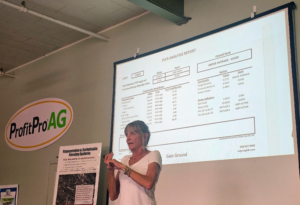Use the Haney Test to Unlock Free Fertilizer in Your Field Part 2
Think you could drop nitrogen (N) to less than a pound per acre—or even lower—without hurting your return on investment (ROI)? It’s time to look at the Haney test, which has been called the only soil test that’s designed to directly reduce fertilizer applications.
“Managing nitrogen more effectively is the biggest way you can save money using the Haney test,” said Liz Haney, a soil scientist who helped her husband, Rick, develop this powerful test. “You can sometimes reduce potash applications with a Haney test, too.”
The Haney test replicates some of the natural processes that occur in a field and accounts for that microbial activity, along with other key measures of soil fertility. “We measure how active the soil microbes are,” Haney said.  That’s why ProfitProAG invited Liz Haney to lead a half-day workshop at our headquarters in Minnesota to help farmers learn how to interpret the data from the Haney test.
That’s why ProfitProAG invited Liz Haney to lead a half-day workshop at our headquarters in Minnesota to help farmers learn how to interpret the data from the Haney test.
Most soil tests don’t sufficiently account for soil microbes. This is a huge oversight, since beneficial soil microbes mineralize organic N, making more of it available to the crop. The Haney test measures the organic and inorganic N in the soil. “It’s a myth that plants only take up inorganic N,” Haney said. “The fact is that plants prefer to take up organic N, because they can use it more efficiently.”
It’s not uncommon for farmers who are using the Haney test to apply .8 to .9 pounds of N per acre, while some are only using .6 to .75 pounds of N per acre, without sacrificing yield or profit potential. “When you apply excess fertilizer, your ROI goes down,” Haney said.
Reducing N also helps control weeds. “Waterhemp loves excess N,” Haney noted.
Since better weed control reduces the need for herbicides, this also boosts your ROI, she added.
Are you listening to your soil microbes?
It all goes back to biology. “If you’re trying to help plants grow, you’re in a biological system and need to understand how it works,” said Dr. Jim Ladlie, founder and CEO of ProfitProAG.
Soil is filled with billions of microbes. These beneficial soil microbes take in oxygen and give off carbon dioxide, just like we do. “The more active the soil microbes’ respiration, the more N is mineralized, and nutrient cycling is optimized,” Haney said.
Nutrient cycling is a natural process where beneficial microorganisms harvest nutrients (including phosphorus, potassium, calcium, iron, boron, and more) from soil organic matter, as well as rocks, silt, and clay in the soil.
Plants are not capable of directly accessing the nutrients in these materials. Bacteria and fungi, however, produce enzymes that break down these structures, releasing the nutrients they contain. When these natural, biological processes work well in a healthy soil, plant roots can easily absorb this nutrient-dense, liquid food source.
If a soil test doesn’t account for the soil microbial activity that makes nutrients available to plants, you don’t get a clear picture of your soil’s fertility needs. That often leads to applying more fertilizer than you need.
Conventional soil tests only focus on physical and chemical factors, without measuring the biology in the soil. “Twenty years ago, we didn’t know how to measure organic N or measure microbes in the soil,” Haney said. “Now we can do this with the Haney test.”
Know your numbers
With the Haney test, samples are pulled from the top 0 to 6 inches of the soil. That’s where most (85% to 90%) of the microbial activity in the soil occurs. “If you pull soil samples down to 12 inches, there’s still microbial activity at this depth, although it’s about half of what’s going on in the top 6 inches of the soil,” Haney said.
The Haney test provides a unique health score for your soil, with measurements on available nutrients and microbial activity, along with cover crop recommendations. ProfitProAG is here to help you make sense of your data from the Haney test, including:
- Soil health calculation (SHC). This score can range from 0 to 50 — the higher the better. While land management has considerable influence on your score, your score can also be limited by regional constraints (soil type, geography, and environmental factors).
- Water-extractable organic carbon (WEOC). This measures the microbes’ food source—specifically, organic carbon.
- Microbially active carbon (MAC). “This measures how much the microbes like the food,” Haney said.

Living roots pump carbon into the soil. Increasing above-ground diversity (by seeding cover crops, for example) creates more below-ground diversity with the beneficial soil microbes. “It creates a ‘food court’ with options for the soil microbes,” Haney said.
A healthy soil food web thrives on diversity. In fact, diverse microbes handle diverse nutrient-cycling jobs, Haney explained. “Some microbes mobilize phosphorus, for example, while others mobilize potassium. Healthier soils with a diverse array of microbes require fewer fertility inputs.”
- PLFA (phospholipid fatty acid) analysis. The PLFA test provides a real-time snapshot of the soil microbial community. “You can see how many bacteria, fungi, and protozoa there are, and in what balance,” Haney said. The PLFA pays special attention to:
- Arbuscular mycorrhizal fungi (AMF) are critical for phosphorus uptake.
- Saprophytic fungi, which help break down residue in the field.
- Protozoa. These tiny predators release nutrients like nitrogen as they graze on bacteria.
Most soils don’t have protozoa in them, Haney noted. Protozoa are the “lions” of the soil, however, meaning they’re at the top of the food chain. “They are responsible for most of the nutrient supply,” Haney said. “If there are no protozoa in your soil, it means you’re tilling the soil too much.”
Supercharge your soil with algae, cut fertilizer, boost yield potential
Along with reducing tillage, applying algae is a significant step in improving soil health. “Algae helps feed protozoa in the soil,” Haney said. “Root hairs are where the magic happens in the soil. Algae make the roots more active and feed the surrounding microbes.”
ProfitProAG distributes EnSoil Algae™, a live-cell algae that can be tank-mixed and sprayed, either on the soil or through foliar applications. It helps improve grain quality, test weight, and yield potential by helping unlock free fertilizer that’s already in the soil.
The payoffs can be big when you build soil biology and back off on the applied nutrients. “This is where the economic opportunity is with algae,” said Tucker Garrigan, director of sales and partner development for EnSoil Algae™, which can help farmers reduce their commercial fertilizer by a third—or more. “It’s not uncommon for growers to cut their fertilizer by at least 50%.”
EnSoil Algae harnesses the power of Chlorella vulgaris (Latin for “common green”) to build your soil biology bank. This ancient species of freshwater green algae is found almost everywhere around the globe. “This algae has evolved over millions of years, and it’s extremely durable,” Garrigan said. “It can handle cold temperatures and low or high pH.”
Russell Hedricks, who farms with regenerative ag practices on his farm in North Carolina, applied a live Chlorella vulgaris algae formulation three times during the growing season when he produced nearly 460 bushels of corn per acre. He estimated that the biostimulant boosted yield by 17 bushels per acre.
“Live algae is one of the most powerful, efficient biologicals you can apply, and it plays well with others,” said Garrigan, who noted that EnSoil Algae works with humic acid and fulvic acid, as well as other biologicals. “It’s 1 + 1 = 3.”
Control the controllables
While there’s a lot you can’t control in farming, like the weather, commodity prices, or fertilizer prices, there are a lot of things you can control—like applying algae and using data from the Haney test to guide your management decisions.
The Haney test can offer important insights to help you maintain yields and put more money back in your pocket, but it’s a guideline. “As you use the Haney test, consider the context of your farm to determine fertilizer recommendations for your acres,” Haney said.
Let’s talk
Want to know more about putting the Haney test to work on your acres? ProfitProAG is here to help. Contact us for more details.
Office – 507-373-2550 / info@profitproag.com
Dr. Jim Ladlie – 507-383-1325 / jladlie@profitproag.com
Dennis Klockenga – 320-333-1608 / dklockenga@profitproag.com
Chris Chodur – 507-402-4195 / cchodur@profitproag.com
